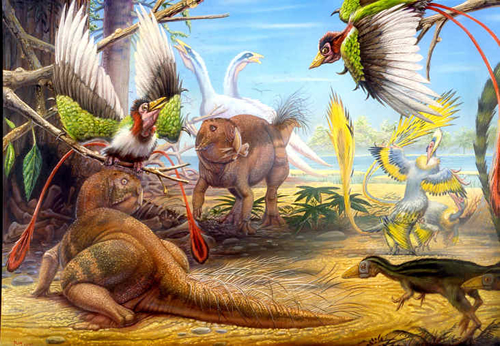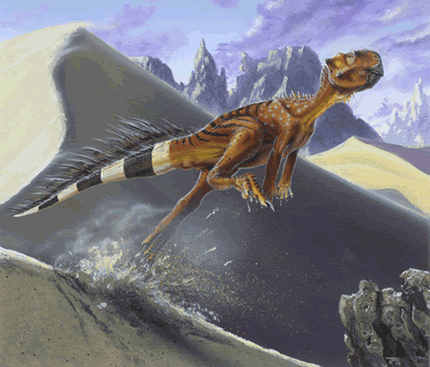Psittacosaurus mongoliensis - Heribivore Dinosaurs
Homepage > Herbivore Dinosaurs - Psittacosaurus mongoliensis
(sit-tack-oh-sor-uhss)
"parrot lizard"
Describer Osborn, 1923
Also Known As Protiguanodon Osborn, 1923; Luanpingosaurus
Cheng vide Chen, 1996
Type of Species
Order Ornithischia
SubOrder Cerapoda
InfraOrder Ceratopsia
Micro-Order --
Family Psittacosauridae
Size 8 feet(2.5 meters) long
Period Early Cretaceous, about 130 million years ago
Fossilsite Asia
Diet herbivore
Species
Psittacosaurus mongoliensis (type)
Osborn, 1923
Psittacosaurus sinensis
Young, 1958
Psittacosaurus meileyingensis
Sereno et al., 1988
Psittacosaurus xinjiangensis
Sereno & Zhao, 1988
?Psittacosaurus sattayaraki
Buffetaut & Suteethorn, 1992
Psittacosaurus neimongoliensis
Russell & Zhao, 1996
Psittacosaurus ordosensis
Russell & Zhao, 1996
Psittacosaurus mazongshanensis
Xu, 1997
Psittacosaurus sibiricus
Leshchinskiy et al., 2000
Psittacosaurus lujiatunensis
Zhou et al., 2006
Psittacosaurus major
Sereno et al., 2007
Psittacosaurus gobiensis
Sereno, Zhao and Lin, 2009
Psittacosaurus was discovered in Outer MOngolia in 1922, during an expedition by the American Museum of Natural History between 1922 and 1925. This dinosaur was named by Henry Osborn after its beaklike appearance of its face. Several well preserved skeletons have been discovered, which represent about eight different species from Mongolia, southern Siberia, and northern China, as well as from some lower jaw fragments that were discovered in northern Thailand.
Psittacosaurus was one of the earliest dinosaurs to show the typical beaked face of the ceratopsian group. This specific feature distinguishes the ceratopsians from all other dinosur groups. Psittacosaurus was one of the smallest and most primitive of the ceratopsians. It grew to weight as much as 110 pounds. Psittacosaurus lack well-developed frills and horns like many other more advanced ceratopsians. But its skull shape was characteristic of ceratopsian group. This dinosaurs possessed sharp, slicing teeth that made it adapted for shredding hard plant matter.
Psittacosaurus hindlegs were longer than its forelimbs, which suggests that it could have moved about in an upright position for short distancdes. It may have done so to avoid attacks from predators. Or may have stood on its hindlegs to be able to reach vegetation in trees. Gastroliths have been found in some skeletons, which helped the dinosaur to mechanically break down plant matter in its stomach.
World's Smallest Dinosaur!
Dinosaur hunters have found several fossils of young Psittacosaurus. One
of these is only 12 in.(24 centimeters) long, making it the smallest dinosaur
ever discovered.
Psittacosaurus mongoliensis Paleo Gallery
Click on images to see more art from artist!


